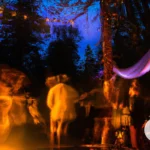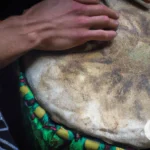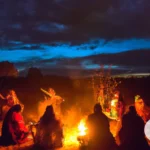New Age Shamanism is a topic that has been attracting both interest and criticism in recent years. As the New Age movement gains more followers, its integration with traditional Shamanism practices is creating a lot of controversial discussions. On one hand, some see it as a way to reconnect with ancient spiritual practices and bring them to the modern world. On the other hand, there are concerns about appropriation, commercialization, and the devaluation of the traditional Shamanic practices. In this article, we will explore the different perspectives on New Age Shamanism and analyze the criticisms, debates, and controversies surrounding it.
The New Age Movement and Shamanism

Shamanism has been practiced for centuries, but in recent years it has gained popularity through the New Age movement. This movement is characterized by seeking alternative spirituality and making use of unconventional practices in pursuit of personal growth. New Age Shamanism, therefore, involves the integration of traditional shamanic practices with contemporary spiritual beliefs. This has led to the creation of new, hybrid practices that fuse elements of various traditions and cultures. However, this syncretism has been a subject of controversy, with criticism focused on issues such as cultural appropriation, lack of training and cultural understanding, and the devaluation of traditional practices. These debates illustrate the complexity of shamanism, its role in modern spirituality, and the challenges of integrating traditional practices into our contemporary culture.
Definitions and Origins
New Age shamanism is a hybrid practice that combines elements of traditional shamanism with a variety of contemporary spiritual beliefs. Shamanism itself is a term used to describe a variety of indigenous spiritual practices that involve a shaman, or spiritual leader, using ecstatic trance states to connect with spirits and enter alternate realities. These practices originated in cultures all over the world, from Native American tribes to Siberian shamanic traditions.
New Age shamanism, on the other hand, originated in the 1960s and 70s as part of the larger New Age movement. While it incorporates some traditional shamanic practices, it also incorporates elements of other spiritual practices, such as astrology and meditation. One of the defining characteristics of New Age shamanism is its focus on personal growth and spiritual development.
There is some debate over whether New Age shamanism can truly be considered shamanism at all. Critics argue that it is a watered-down, Westernized version of traditional practices that fails to respect their origins and culture. Others argue that it is a valid expression of spirituality that can provide people with meaningful experiences and transformative insights.
Regardless of these debates, it is clear that New Age shamanism has gained a significant following in recent decades. It has been popularized through books, workshops, and retreats, and has even been incorporated into some forms of psychotherapy.
Overlap and Syncretism
New Age shamanism is inherently syncretic, which means that it blends together various religious and spiritual beliefs and practices. This syncretism can sometimes lead to an overlap with other belief systems and religious practices. The overlap can cause conflict, especially when the beliefs and practices are meant to be separate.
For example, New Age shamanism may have elements of Hinduism, Buddhism, or Native American spirituality. Critics argue that this creates confusion and, at times, outright contradiction. An example of this can be seen in the use of the term “smudging” by New Age shamans. The term refers to a traditional Native American practice of using smoke to purify a space. Some argue that its use in the context of New Age spirituality is problematic as it is not a practice that can be freely adopted by non-Native practitioners.
Another criticism is the fact that New Age shamanism often borrows heavily from traditional shamanism, often without due acknowledgement. This has led to debates about the legitimacy of these practices and whether or not they should be considered “true” shamanism.
Despite these controversies, many practitioners of New Age spirituality argue that syncretism is a positive thing as it allows for the blending of various beliefs and practices. This can result in a more holistic approach to spirituality and personal growth.
The overlap and syncretism that is inherent to New Age shamanism carries with it both advantages and disadvantages. While it allows for the blending of different spiritual practices, it can also lead to appropriation and a lack of cultural understanding.
The Criticisms of New Age Shamanism
The controversies surrounding new age shamanism stem from a variety of criticisms of the movement. One major criticism is appropriation and commercialization, where individuals profit from traditional spiritual practices without respecting their cultural significance. This trend has led to the devaluation of traditional practices and a lack of understanding of the deeper meanings behind them. Additionally, lack of training and cultural understanding within the new age shamanism movement belittles the practices and language of traditional shamans. This lack of respect towards cultural traditions fits within a broader narrative of colonialism, where western cultures tend to cherry-pick practices from other cultures. Understanding this dynamic is key to developing a framework for authentic spiritual practices. It is important to examine both the criticisms and the resulting pushback.
Appropriation and Commercialization
One controversy surrounding new age shamanism is the issue of appropriation and commercialization. Some critics argue that practitioners of new age shamanism appropriate and commodify the spiritual practices of indigenous cultures without proper understanding or respect for their origins. This has led to the commercialization of indigenous cultures, with people profiting off of selling things like smudging kits, dreamcatchers, and other spiritual objects.
The commodification of traditional practices by new age practitioners raises important ethical questions. Is it right to profit off of something that is culturally sacred and meaningful to a specific community? Should spiritual practices be sold as commodities for people to consume without proper training and understanding?
Another issue with the appropriation of indigenous practices in new age shamanism is the erasure of the cultural context and history behind the practices. Many new age practitioners adopt spiritual practices from indigenous cultures without understanding the cultural significance of those practices. In doing so, they strip away the cultural context and history of these practices, reducing them to mere trends in the spiritual market.
It’s important to note that not all new age shamanism is guilty of appropriation and commodification. Some practitioners are respectful and mindful of the cultural origins behind the practices they adopt. However, it’s essential to approach these practices with critical awareness and a deep respect for their origins.
If you want to learn more about the differences between contemporary and traditional shamanism, follow this link.
Devaluation of Traditional Practices
The devaluation of traditional practices is one of the most controversial issues surrounding New Age Shamanism. This practice has been criticized for undermining the cultural practices and traditions of indigenous communities, which are the originators of shamanic practices. Here are some examples of how traditional practices are devalued:
| Issue | Explanation |
| Trivialization | Some practitioners of New Age Shamanism tend to treat traditional practices as mere entertainment or novelty, failing to appreciate the depth of meaning behind them and the important role they play in indigenous communities. |
| Adaptation | Some New Age Shamans adapt traditional practices to suit their personal beliefs or needs, without fully understanding the cultural context and significance of those practices. This can lead to misinterpretations or distortions of traditional teachings. |
| Commercialization | Some New Age Shamans use traditional practices to promote products or services, such as workshops, retreats, or healing sessions. This can contribute to the exploitation of indigenous cultures and the commercialization of sacred practices. |
| Omission | Some practitioners of New Age Shamanism omit or ignore the spiritual and cultural roots of traditional practices, focusing only on the psychological or therapeutic aspects. This can result in the loss of spiritual and cultural knowledge and wisdom. |
The devaluation of traditional practices is a serious concern for many indigenous communities and scholars of shamanism. It undermines the diversity and richness of shamanic traditions and disrespects the cultural heritage of indigenous peoples. As such, it is important for practitioners of New Age Shamanism to approach traditional practices with humility, respect, and an open mind, seeking to learn from the wisdom of indigenous cultures rather than exploiting or appropriating their practices.
Lack of Training and Cultural Understanding
The lack of proper training and cultural understanding is one of the major criticisms of the New Age Shamanism movement. Many individuals who consider themselves to be shamans, or who claim to follow shamanic practices, do not have any training or apprenticeship in traditional shamanic cultures. Instead, they have attended workshops, read books, or taken online courses, which does not qualify them to understand or practice these ancient beliefs.
This lack of training and understanding can lead to a shallow and superficial understanding of shamanism. Shamanism is deeply rooted in traditional cultural practices, and it is an intricate part of the lives of indigenous communities around the world. Without proper training, it is impossible to understand the context, symbolism, and spiritual significance of shamanic practices. This lack of understanding can lead to the appropriation of shamanic practices, leading to their commercialization and incorrect representation.
There is a risk of insulting or disrespecting traditional cultures through a lack of cultural understanding. In many traditional cultures, shamanism is an extensive and complex practice, that requires apprenticeships of years or even decades. When individuals try to practice shamanism without proper training, they may end up misrepresenting or appropriating these cultures. This problem is particularly prevalent in the Western New Age movement, where shamanic practices have been adopted without proper cultural understanding or appreciation.
The lack of training and cultural understanding is a significant problem in the New Age Shamanism movement. Without proper apprenticeships or training, individuals risk promoting an incomplete and disrespectful representation of shamanic practices. Cultural appropriation and commercialization can further erode the spiritual and cultural significance of shamanism. It is thus crucial to have an appreciation of tradition and culture while seeking spiritual growth.
The Debates Within New Age Shamanism
The debates surrounding New Age Shamanism are complex and multifaceted, with numerous arguments for and against the incorporation of shamanic practices into modern spirituality. Some proponents argue that New Age Shamanism offers a way for individuals to connect with their spiritual selves and build a sense of community, while others are concerned about issues such as cultural appropriation and the commercialization of traditional practices. One major debate within the New Age Shamanism community revolves around authenticity and legitimacy, with some followers arguing that only those with extensive training and cultural understanding should be considered true shamans. Others believe that anyone can learn to practice shamanism, and that it is more important to focus on building a personal connection with nature and the spiritual world. Finally, there is also a growing debate about the ethics and responsibilities of New Age Shamanism, and the role that practitioners should play in preserving and honoring traditional practices and cultures.
Authenticity and Legitimacy
The issue of authenticity and legitimacy is one of the biggest debates surrounding New Age shamanism. Those who practice this form of spirituality often incorporate elements of various indigenous cultures, including rituals, ceremonies, and healing practices. However, many argue that these practices are being appropriated and stripped of their true meaning and significance.
Authenticity is a crucial factor in New Age shamanism as many teachings and practices are rooted in ancient traditions. Often, these practices have been passed down through generations and carry deep cultural and spiritual significance. However, with the rise of New Age spirituality, many of these practices have become commodified and simplified.
The question of legitimacy arises because many of those who claim to be Shamans have not received formal training or certification. This lack of regulation and standardization in the field has led to concerns regarding the efficacy and safety of the practices being used.
While some argue that those who have not been trained in traditional practices should not practice shamanism, others believe that anyone can develop the necessary
Subscribe to Our Newsletter
Sign up to receive the latest news and updates.
In the end, the debate surrounding authenticity and legitimacy in New Age shamanism boils down to respect for cultural traditions and a commitment to responsible spiritual practice. It is necessary to acknowledge the origins and significance of the practices being used while also allowing for personal exploration and growth. Ultimately, the goal should be to create a more inclusive and respectful spiritual community that values both tradition and innovation.
Integration with Traditional Practices
Integration with traditional practices is a topic that is highly debated within the realm of new age shamanism. On one hand, there are those who argue that the integration of traditional practices is necessary in order to maintain authenticity and respect for the original form of shamanism. On the other hand, there are those who argue that the integration of these practices can be harmful and disrespectful if not done properly.
The Arguments for Integration
One of the main arguments for integrating traditional practices into new age shamanism is that it helps to maintain the authenticity and legitimacy of the practice. By using traditional techniques and methods, practitioners can tap into the wisdom and knowledge of those who have gone before them.
Another argument for integration is that it helps to bridge the gap between different cultures and traditions. By learning from traditional practitioners, new age shamans can gain a deeper understanding of the cultural and spiritual roots of shamanism. This can help to promote a greater sense of respect and understanding between different groups of people.
The Arguments Against Integration
One of the main arguments against the integration of traditional practices is that it can be disrespectful and harmful if not done properly. For example, many traditional shamanic practices are highly ritualized and require a great deal of training and expertise to perform safely and effectively. Attempting to use these practices without proper training and cultural understanding can be dangerous and disrespectful.
Another argument against integration is that it can lead to the dilution and commercialization of traditional practices. When traditional practices are integrated into new age shamanism, they can become divorced from their original cultural and spiritual contexts. This can lead to practices being simplified or altered in order to appeal to a broader audience, which can dilute the power and effectiveness of these practices.
Examples of Integration
One example of integration is the use of smudging, which is a traditional Native American practice for cleansing and purifying a person or space. This practice has been integrated into new age shamanism as a way of clearing negative energy and promoting spiritual balance.
Another example is the use of plant medicines, such as ayahuasca or peyote, which have been used in traditional shamanic practices for centuries. These medicines have been integrated into new age shamanism, although there is some debate about whether their use outside of traditional contexts is appropriate or respectful.
| Arguments For Integration | Arguments Against Integration |
|---|---|
| Maintains authenticity and legitimacy | Can be disrespectful and harmful if not done properly |
| Bridges the gap between different cultures and traditions | Can lead to dilution and commercialization of traditional practices |
Integration with traditional practices is a complex and highly debated topic within the realm of new age shamanism. While there are valid arguments both for and against integration, it is clear that any attempt to integrate traditional practices should be done with a great deal of care and respect for the original cultural and spiritual context in which these practices were developed.
Ethics and Responsibilities
Ethics and responsibilities are crucial aspects of any spiritual practice, and New Age Shamanism is no exception. As a spiritual practice that involves working with individuals and communities, it is important for New Age Shamans to establish a framework of ethical principles and responsibilities.
Ethics: Ethics refer to a set of moral principles that guide the conduct of individuals. In New Age Shamanism, ethics can include principles such as respect for individuals and their beliefs, honesty with clients, and the importance of consent. However, the lack of official guidelines or governing bodies in New Age Shamanism can make it difficult to establish a set of universal ethical principles.
Responsibilities: The responsibilities of New Age Shamans go beyond their ethical conduct. They also have a responsibility to ensure that their clients are not harmed in any way during spiritual practices. This involves ensuring that clients are not exposed to any harmful substances or practices, and that their physical and emotional well-being is always prioritized.
One of the biggest debates within New Age Shamanism is the issue of ethics and responsibilities. While some argue that individual shamans should determine their own ethical principles and responsibilities, others argue for the establishment of official guidelines and governing bodies to ensure consistency and accountability.
Examples of ethical principles:
- Respect for the beliefs and practices of clients
- Honesty in communication with clients
- Maintaining confidentiality and privacy of clients
- Obtaining informed consent before carrying out any spiritual practices
- Respecting the physical and emotional well-being of clients
Examples of responsibilities:
- Providing a safe and comfortable environment for spiritual practices
- Ensuring that clients are not exposed to any harmful substances or practices
- Prioritizing the well-being of clients over personal gain or profit
- Being knowledgeable about the potential risks and benefits of spiritual practices
- Providing appropriate aftercare and support for clients
It is important for both individual shamans and the wider community of New Age Shamans to engage in ongoing dialogue and reflection about the ethical principles and responsibilities involved in their practices. By doing so, the practice can continue to evolve and develop in a way that is both authentic and responsible.
Conclusion
As we have explored in this article, New Age Shamanism is a complex and controversial topic. While it has brought new attention to traditional practices and spiritual beliefs, it has also been criticized for commercialization and appropriation. The debates within the New Age movement show a struggle for authenticity and a responsibility to respect cultural traditions.
In conclusion, the controversies surrounding New Age Shamanism are not easily resolved. On one hand, it can bring new interest to traditional practices and spiritual beliefs. On the other hand, it can perpetuate cultural appropriation and devalue the rich histories of indigenous cultures. To move forward, it is crucial for those interested in New Age Shamanism to acknowledge their privilege and commit to proper education, cultural understanding, and respectful integration of traditional practices. Let us strive to promote proper awareness and understanding of New Age Shamanism, supporting its genuine benefits while avoiding appropriation, devaluation, and commercialization.
Frequently Asked Questions
What is the New Age Movement?
The New Age Movement is a spiritual movement that emerged in the Western world during the 1970s and 1980s. It includes a diverse range of beliefs and practices, including alternative forms of healing, meditation, and spirituality.
What is Shamanism?
Shamanism is an ancient spiritual practice found in many indigenous cultures around the world. It involves a shaman or medicine man/woman acting as an intermediary between the physical and spiritual realms to facilitate healing and communication with spirits.
What is the overlap between New Age and Shamanism?
The New Age Movement often incorporates elements of Shamanism, such as using meditation, ritual practices, and the exploration of altered states of consciousness in their spiritual practices.
Why is New Age Shamanism controversial?
New Age Shamanism is controversial because of concerns about cultural appropriation, misrepresentation, and commercialization of traditional indigenous practices.
What is cultural appropriation?
Cultural appropriation is the adoption or use of elements of one culture by members of another culture. It is often seen as problematic when it involves the borrowing of sacred or meaningful symbols, practices, or rituals without understanding the context and meaning behind them.
How does New Age Shamanism contribute to cultural appropriation?
New Age practitioners often use elements of Shamanism without understanding the cultural context and significance behind them. This can lead to the dilution and commodification of traditional practices, which can be seen as disrespectful and insensitive.
What is the devaluation of traditional practices?
The devaluation of traditional practices refers to the reduction of the value and meaning of indigenous practices when they are co-opted by outside groups without proper context and understanding. This can lead to the loss of cultural significance and erosion of indigenous knowledge and traditions.
What are the main criticisms of New Age Shamanism?
The main criticisms of New Age Shamanism include cultural appropriation, the devaluation of traditional practices, and a lack of proper training and cultural understanding among practitioners.
What is the debate around authenticity and legitimacy in New Age Shamanism?
The debate around authenticity and legitimacy in New Age Shamanism centers on whether or not non-indigenous practitioners have the right to use and teach traditional practices. Some argue that it is important to honor and preserve traditional indigenous knowledge, while others believe that spiritual practices should be open to all.
How can practitioners address concerns around cultural appropriation in their spiritual practices?
Practitioners can address concerns around cultural appropriation by educating themselves on the cultural context and significance of the practices they are using, seeking permission and guidance from indigenous practitioners, and being mindful of how they share and talk about the practices with others.










